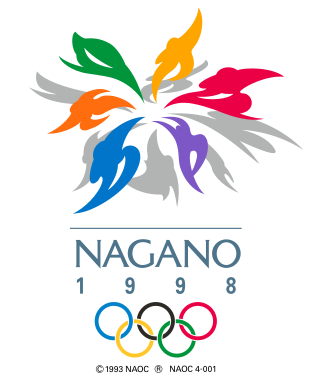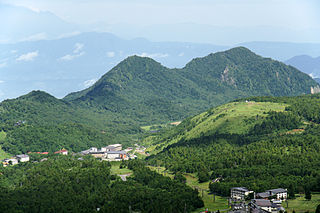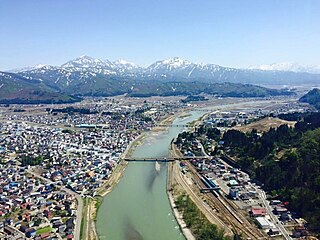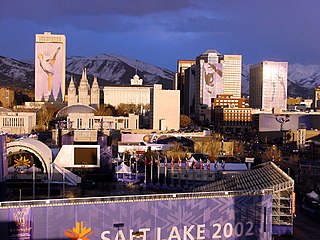
The 1998 Winter Olympics, officially known as the XVIII Olympic Winter Games and commonly known as Nagano 1998, were a winter multi-sport event held from 7 to 22 February 1998, mainly in Nagano, Nagano Prefecture, Japan, with some events taking place in the nearby mountain communities of Hakuba, Karuizawa, Nozawa Onsen, and Yamanouchi. The city of Nagano had previously been a candidate to host the 1940 Winter Olympics, as well as the 1972 Winter Olympics, but had been eliminated at the national level by Sapporo on both occasions.

Myōkō is a city located in Niigata Prefecture, Japan. As of 1 November 2020, the city had an estimated population of 31,374 in 12,408 households, and a population density of 70 people per km². The total area of the city was 445.63 square kilometres (172.06 sq mi). Myōkō is a member of the World Health Organization’s Alliance for Healthy Cities (AFHC).

Iiyama is a city located in Nagano Prefecture, Japan. As of 1 February 2019, the city had an estimated population of 20,118 in 7372 households, and a population density of 99 persons per km2. The total area of the city is 202.43 square kilometres (78.16 sq mi). It markets itself as "Japan's Hometown" and is known as the "Little Kyoto of Snow Country".

The 1998 Winter Paralympics, the seventh Paralympic Winter Games, were held alongside the Winter Olympics in Nagano, Nagano Prefecture, Japan from 5 to 14 March 1998. They were the first Paralympic Winter Games to be held in Asia. 571 athletes competed in Nagano; as 2022 it remains the highest number of athletes competing at any Winter Paralympics.

Hakuba is a village located in Nagano Prefecture, Japan. As of April 1, 2019, the village had an estimated population of 9,007 in 4267 households, and a population density of 48 persons per km2. The total area of the village is 189.36 square kilometres (73.11 sq mi). Hakuba is located in the eastern foothills of the Hida Mountains in the northern part of the Japanese Alps and is world famous as a ski resort. It is also the starting point for trekking Mount Shirouma and Mount Goryu, two of the One Hundred Mountains of Japan. As the surrounding valley has an annual snow fall of over 11 meters, it is the central hub for 10 ski resorts with more than 200 runs. The village was the main event venue for 1998 Winter Olympics.

Yamanouchi is a town located in Shimotakai District in Nagano Prefecture, Japan. As of 1 April 2019, the town had an estimated population of 12,403 in 5020 households, and a population density of 47 persons per km2. The total area of the town is 265.90 square kilometres (102.66 sq mi).

Nozawaonsen is a village located in Nagano Prefecture, Japan. As of 1 April 2019, the village had an estimated population of 3,653 in 1,395 households and a population density of 63 persons per km². The total area of the village is 57.96 square kilometres (22.38 sq mi).
Myōkōkōgen was a town in Nakakubiki District, Niigata Prefecture, Japan

Tsumagoi is a village located in Gunma Prefecture, Japan. As of 1 September 2020, the village had an estimated population of 9,546 in 3,999 households, and a population density of 28 persons per km². The total area of the village is 337.51 square kilometres (130.31 sq mi).

Ōwani is a town located in Aomori Prefecture, Japan. As of 31 January 2023, the town had an estimated population of 8,669 people in 4108 households and a population density of 53 persons per km2. The total area of the town is 163.41 square kilometres (63.09 sq mi). Skiing is very popular in Ōwani Town, and seven Olympic athletes have grown up there.

Uonuma is a city located in Niigata Prefecture, Japan. As of 1 July 2019, the city had an estimated population of 35,027 in 13,289 households, and a population density of 37 persons per km2. Its total area is 946.76 square kilometres (365.55 sq mi). The city is famous for its koshihikari rice, which commands a premium in the Japanese market.

Shiga Kogen is a ski resort and hiking spot, located in the Jōshin'etsu-kōgen National Park in the highlands of Yamanouchi, Nagano, Japan. In 1980, an area of 13,000 hectares (50 sq mi) was designated a UNESCO Man and the Biosphere Reserve.

Iizuna Kogen Ski Area is a skiing area located in Nagano, Nagano, Japan. It is operated by Nagano City.

For the 1998 Winter Olympics in Nagano, Japan, a total of fifteen sports venues were used. Nagano had attempted twice to host the Winter Olympics, losing out to Sapporo, host of the 1972 Winter Olympics. The third time, in 1991, Nagano edged out Salt Lake City to host the 1998 Games. The biathlon venue was adjusted in accordance with the Washington Convention over endangered species. The biggest venue controversy was at Happo'one resort on the length of the men's downhill and the battle that ensued to the point where skiing officials threatened to pull the event entirely before a compromise was reached three months before the Olympics. M-Wave has hosted three World Speed Skating Championships since the Olympics, while the Spiral has hosted a couple of world championships in bobsleigh, luge and skeleton.

The 2002 Winter Olympic Games were held in and around Salt Lake City, United States from February 8 to 24, 2002, and the Paralympics from March 7 to 16, 2002. The sporting events were held in ten competitive venues, while non-competitive events, such as the opening ceremony, were held in six other venues. Three venues were also created for training purposes. All Olympic venues were scattered throughout Northern Utah and the Wasatch Front.

The Yamagata Zao Onsen Ski Resort is the largest ski resort in Tōhoku region, Japan, operated by Zao Onsen Tourism Association.
The Men's 4 x 7.5 kilometre biathlon relay competition at the 1998 Winter Olympics 21 February, at Nozawa Onsen. Each national team consisted of four members, with each skiing 7.5 kilometres and shooting twice, once prone and once standing.
The Women's 4 x 7.5 kilometre biathlon relay competition at the 1998 Winter Olympics 19 February, at Nozawa Onsen. Each national team consisted of four members, with each skiing 7.5 kilometres and shooting twice, once prone and once standing.
The men's 10 kilometre classical cross-country skiing competition at the 1998 Winter Olympics in Nagano, Japan, was held on 12 February at Snow Harp in Nozawa Onsen.

















